| Author | Message | ||
Geoff Wootton Experienced User Username: dounraey Post Number: 47 Registered: 5-2012 |
I am currently overhauling the window lifts on my 1974 Shadow 1. This includes dismantling, cleaning and regreasing the window lift mechanisms and implementing Richard Treacy's electrical modification. I have read the threads on electric windows and there appears to be disagreement on the functioning of the window lift mechanism. The following photograph shows the parts of interest:  The nylon gearwheel engages with a worm drive driven by the electric window motor and this rotates the cog which in turn drives the chain which raises or lowers the window glass. Here are the two views on operation of the window lifts: 1) Either the nylon gearwheel or the cog should slip on the shaft to form a rudimentary clutch system. This is to prevent over-stressing of the window when in it's closed position and also as a safety feature to prevent the accidental chopping off of one's arm. The solenoid is used as a brake to prevent the window sliding down it's runners, leaving the window in it's open position. 2) The gearwheel and cog are pressed onto the shaft and form a rigid structure. The motor is rated such that it will not over-stress the window and has insufficient power to remove said appendage. The solenoid is used as a brake to prevent the whole weight of the window resting on a single cog of the nylon gearwheel. This is not purely an academic question. The gearwheel and cog on my car are fixed. If there indeed needs to be some slip there, then I need to free them off. Geoff. | ||
Paul Yorke Grand Master Username: paul_yorke Post Number: 917 Registered: 6-2006 |
Geoff, go for two, however there is a rubber bush between the metal cog and the shaft. This is to absorb shock but should not have any slip in it at all. The rubber does shear. This can make it look like a clutch or safety device but it is actually a fault. If you can hear the motor still operating at either limit then the gear needs replacing. | ||
Chris Browne Frequent User Username: chrisb Post Number: 98 Registered: 2-2010 |
Hello Geoff, Whilst you are dismantling the window drive mechanisms, I would advise you to check the condition of the nylon gears for cracks. Last year, I was at an RREC event, lowered the drivers window and heard a thud from inside the door as the window reached the bottom of its travel and then couldn't get the window back up again. Fortunately it was a warm dry day so I was able to drive the 90 miles back home with the window down in reasonable comfort. When I removed the door card and lift mechanism, I found the nylon gear had shattered into four pieces. I presume the nylon becomes brittle with age. Just something to check whilst you are in there which might save you some grief on a cold and or wet day in the future! Kind regards, Chris | ||
Brian Vogel Prolific User Username: guyslp Post Number: 176 Registered: 6-2009 |
The first sentence of Geoff's number two is correct. However, the statement, "The solenoid is used as a brake to prevent the window sliding down it's runners, leaving the window in it's open position," doesn't seem to be correct either in theory nor in practice. My understanding of the window "brake" was that it was intended to cause the travel of the window to stop "instantly" when one let go of the lift switch, regardless of which direction the window was traveling. Having torn these down myself, and having seen that the whole brake solenoid was deleted on the SZ series cars (fairly early on, if not at the transition point) it appears that Crewe finally figured out that they don't really serve any useful functional purpose. All of those on my cars are in place and working, but I know of many who've simply removed them and have never seen one iota of difference in the behavior of the windows when a brake solenoid is deleted. Brian | ||
Geoff Wootton Experienced User Username: dounraey Post Number: 48 Registered: 5-2012 |
Chris - thanks for the advice. I have also noted your repair on another thread, given that these parts are difficult to obtain. Brian - The reason I included the statement re: sliding down the runners, is that it is given as the purpose of the solenoid in other threads and would logically be required if a slipping clutch mechanism was used. I agree with your understanding that the brake is there to cause an instant stop of the window and that in practice it is not really required. When I first became the owner of my car I did a quick fix on the painfully slow drivers window. The reduced electrical current to that door was not sufficient to fire the solenoid, so I removed it; a simple job that can be done by removing the door card and unbolting the two set screws in situ. However, I am now having misgivings about this. Without the solenoid brake in place, the entire weight of the window is concentrated onto a single cog of the nylon gearwheel. Furthermore, it is also always the same cog when the window is in it's closed position. I just wondered what the general view was on this as it will help me to decide whether or not to refit the solenoids. I really appreciate the comments. Geoff | ||
Brian Vogel Prolific User Username: guyslp Post Number: 177 Registered: 6-2009 |
Geoff, I don't really think that the brake, even when it works, is ever effective enough to hold the entire weight of the window itself under any circumstances. I could have sworn I took documentary photos when I had the entire motor/transmission/brake assembly apart, but I can't find them right now. If memory serves the contacts between the brake solenoid and the washer that pushed against an opposing round plate on the transmission were four very tiny plastic fingers. I don't think these could possibly have applied enough force, nor apply it at precisely the known correct "gear in mid motion" moment to prevent most of the window weight from riding on that gear. Perhaps I'm incorrect, but this is what my gut tells me based upon what I saw, and how the solenoid behaved when turned off or on. Brian | ||
John Kilkenny Prolific User Username: john_kilkenny Post Number: 143 Registered: 6-2005 |
Here's a little exercise for those with cars having solenoid brakes on the window motors. Operate a window switch to raise a window and keep the switch operated when the window reaches the top. After about twenty seconds you will hear a faint click as the overload protection of the motor operates. This disconnects the motor but maintains the solenoid brake off. If the window mechanism is in good condition the window will drop under its own weight though probably not all the way. What does this tell you ? If you use the search facility on this forum you will find quite a lot on the window operation. | ||
Geoff Wootton Frequent User Username: dounraey Post Number: 71 Registered: 5-2012 |
I have just re-read this thread, prompted by a discussion of electric windows on the SZ forum. I cannot believe that on first reading I missed Paul Yorke's response, which for me is the definitive answer to my initial question 'clutch or no clutch' I have since done some reading around the topic of electric windows and am surprised that my original assumption that there are safety systems built into these devices is in fact completely incorrect. According to the website 'Kids and Cars' there have been 50 fatalities and thousands of injuries to young children since 1990. The manufacturers response is to fit a master switch on all cars so that electric window operation can be disabled when carrying young children or pets. I had naturally assumed that electric windows were safe. Not true. There are several references in these forums to the electric window test of closing the window, keeping the switch pressed to disengage the solenoid and watching the window slowly drop down it's runner. So here's the controversial bit, and I absolutely wish to offend no-one on these forums, however it appears that this test would indicate faulty rather than correct operation. It would indicate that the rubber bush between the cog and the shaft has started to shear and at sometime in the future, as the problem gets worse will result in no drive at all to the window as the cog freely skids round on the shaft. The current state of play on my car is that I have removed all the solenoids to no (apparent) detrimental effect. Part of the problem I was having with my slow windows was of low voltage being insufficient to fire the solenoids and release the brakes. I have to agree with Brian's assertion of the efficacy of the brakes given that the windows would lift, albeit very slowly even though the brakes were still being applied. Also that the solenoids, which were later deleted, don't appear to serve any useful functional purpose. I have implemented RT's relay mod to the rear passenger door, so now that I have operational voltage to that door could in theory refit the solenoid, but I doubt there is any point. | ||
Brian Vogel Prolific User Username: guyslp Post Number: 216 Registered: 6-2009 |
Geoff, I guess the safety issue was one that I thought "everyone knew about." I have never tested the "ability to crush" in either my 1996 Buick or 1999 Jaguar, but I recall only too well how efficient 1960s and 1970s electric windows were at applying huge pressures to very small surface areas. Your post prompted me to go back to hunt for the documentary photos I knew I took when working on the window motors in my SW-II, and I found them. I'm posting here just so there is "a visual record" for future readers. These photos are more of a macro view than down to the cogs and gears level.   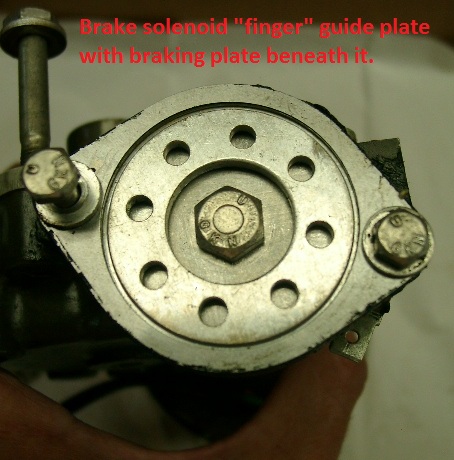 I'll include some photos of the "guts" of one of my motors that had somehow become utterly corroded inside. How this occurred I cannot fathom, but the corrosion ended up being bad enough to have nuked the armature. I had to get a replacement motor from a donor SS-II. 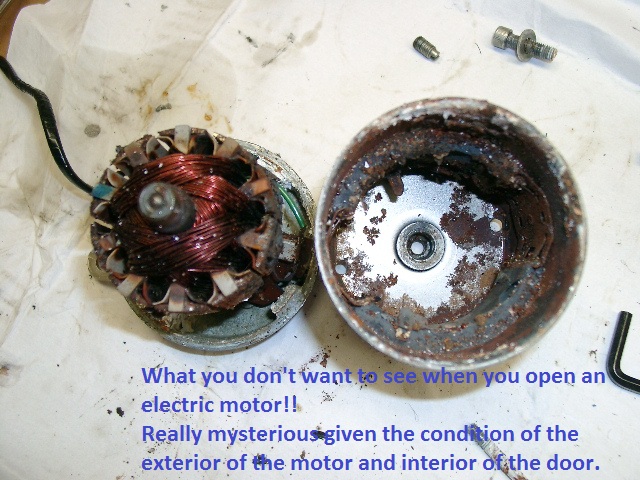 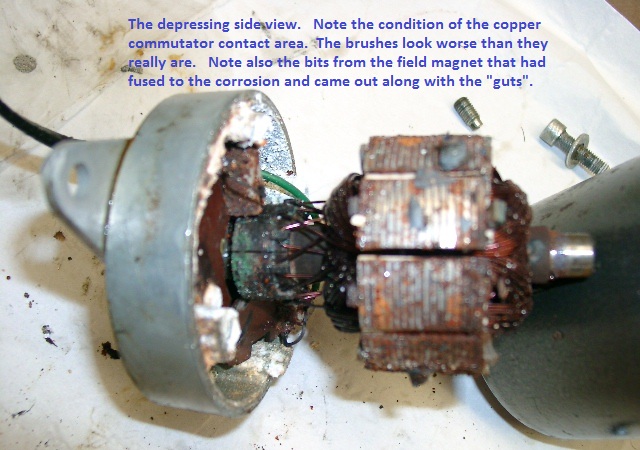 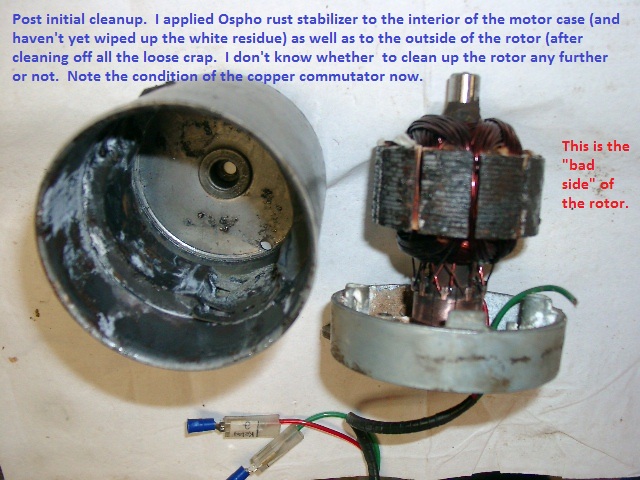 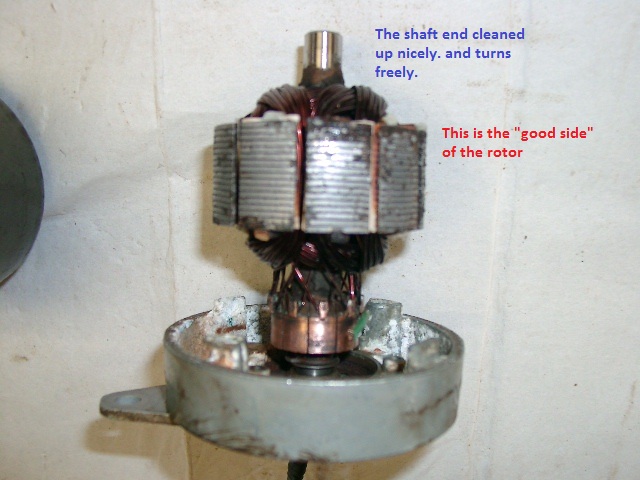 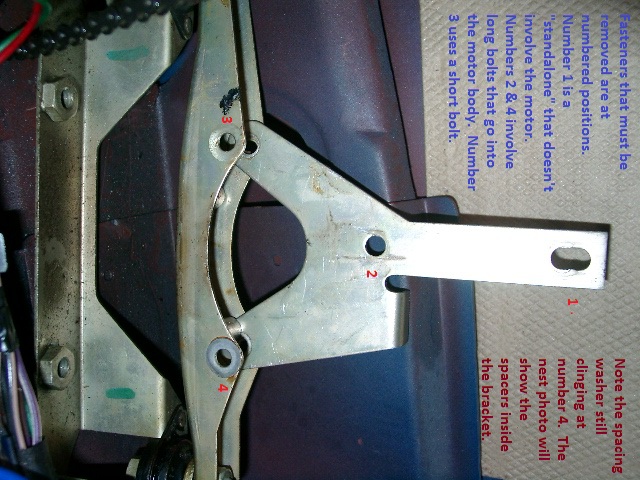 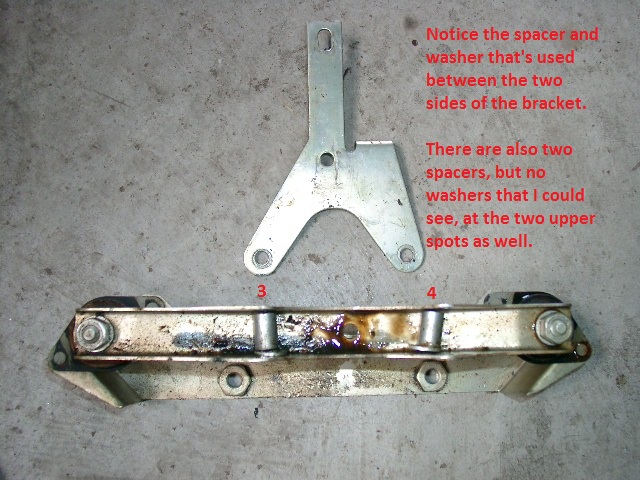 And there ends the collection. Brian | ||
Geoff Wootton Frequent User Username: dounraey Post Number: 72 Registered: 5-2012 |
Brian, I'd never really considered the safety issues of electric windows. I had subconsciously assumed that the master switch was there just to irritate passengers when it was accidentally pushed to the off position. One thing I have noticed in America that you never see in England is that drivers will often have their windows partially open so their pet dogs can put their heads out. It looks really cute. So maybe Americans are just more aware of the need to use the master switch. The point of my referencing the safety aspects in my last entry was when I was dismantling my window lifts I was actively looking for some sort of safety mechanism, like a clutch or cutoff switch. Of course, none was to be found. I am impressed at the excellent condition of the parts you have shown and equally surprised at the internal condition of the motor; quite a mystery. | ||
David Gore Moderator Username: david_gore Post Number: 1197 Registered: 4-2003 |
In the absence of any other evidence of water penetration to the door cavity, my suspicions are a quick and dirty [in both senses] replacement of a dud motor using a second-hand unit from the cheapest supplier just before sale. It appears to me that the motor has been submerged for a short period sometime in its life. | ||
Brian Vogel Prolific User Username: guyslp Post Number: 217 Registered: 6-2009 |
Geoff & David, The car in question was single owner prior to my acquisition. He took delivery in 1979 and for most of its life had it serviced at Bentley High Point (formerly Transco) in North Carolina. He became ill in the last few years of his life, and when I bought the car last January the final state inspection sticker had expired 5 years earlier. There was clearly at least a short period where someone who really didn't know what they were doing had played with the car. The huge line to the ammeter shunt had been cut. I now believe that someone had loosened the allen screw that holds the fan clutch to its pedestal and never tightened it down again. The window motor, though, still remains a mystery. There was no indication that there was any "extreme" moisture penetration in the back door where this motor was located. In fact, the entire environment was virtually pristine, as it is in many aspects throughout the car. I agree that it looks like it had been submerged, and in salt water, but it's so unlikely that this would have left no traces anywhere on the exterior of the motor or environs. I'll never know, that's for sure. I just hope that this is the nadir of my discoveries as I attempt to revive this car from an unfortunately long slumber. This is, of course, proving more difficult than I had ever anticipated, and I never deluded myself into thinking it would be a simple matter. But, I'm very close to getting the Silver Shadow II back to the land of the living. I hope that once that happens I can find her a new custodian so that I only have one SY car to focus my attention on. Brian | ||
John Kilkenny Prolific User Username: john_kilkenny Post Number: 154 Registered: 6-2005 |
On my early Shadow (SRH1405) the solenoid brakes are certainly necessary as all four windows will drop under their own weight without the brakes, as per my previous post. On the other hand I don't have problems with slow window operation. Maybe there was a manufacturing modification to the window mechanism at some stage, perhaps a new motor or a change in gearing, around the time the solenoid brake was no longer fitted. I find it hard to believe that the solenoid brake was initially included for no real reason. | ||
Richard Treacy Grand Master Username: richard_treacy Post Number: 2754 Registered: 4-2003 |
John, Your SY is pre-13754 like mine - my SBH13247 fortunately enjoys the earlier system by just a few chassis. The mechanism is quite different from those of later cars and indeed needs the brake. Without the brake the windows will majestically lower themselves. However, I have seen many of our type of car with dragging brakes which slow the windows. RT. | ||
Geoff Wootton Frequent User Username: dounraey Post Number: 73 Registered: 5-2012 |
John, As you mention, it must be manufacturing modification over the years that is the explanation for the difference in behaviour of the windows. The reason this was an issue for me was the behaviour you describe whereby the windows will drop under their own weight if the window switch is held in the on position is highly desirable as a safety feature. When I found that there was no slip at all between the cog and gearwheel on my car (SRX18501) I needed to know whether to free them off to maintain what I presumed was a safety feature. For various reasons I decided to leave them as they were. It occurs to me that it is possible the early cars may have had different clearances to achieve the slip that required the solenoid brake and that engineers then opted for a rigid press fit on later models. | ||
Geoff Wootton Frequent User Username: dounraey Post Number: 74 Registered: 5-2012 |
Richard's post came in as I was writing my previous entry - all is now explained. |